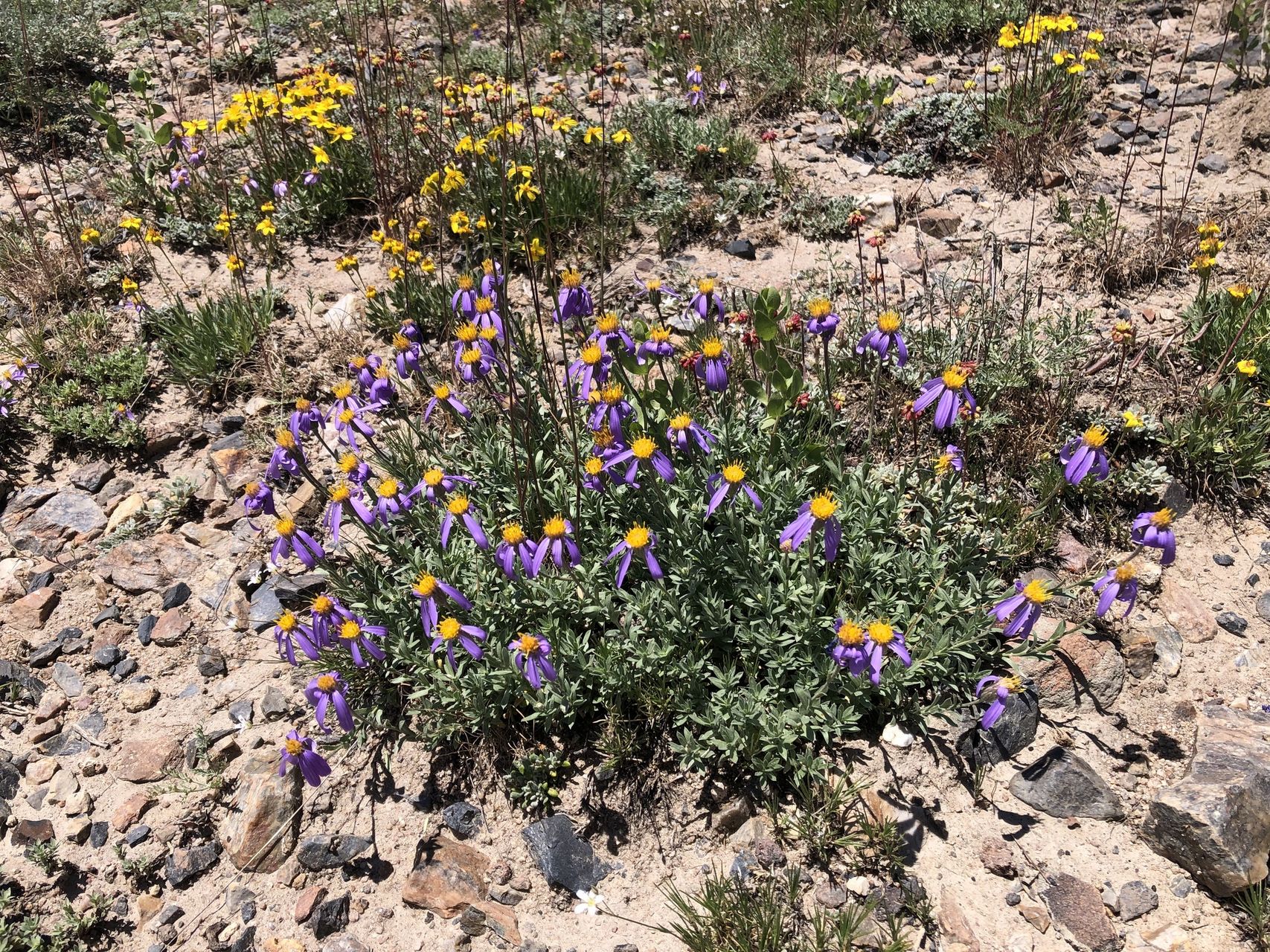Ionactis alpina 14449
Author: (Thomas Nuttall (1786-1859)) Edward Lee Greene (1843-1915)Family: Asteraceae Subfamily: Asteroideae Tribe: Astereae
Genus: Ionactis
Synonym(s): Aster scopulorum
English name: Lava ankle-aster
Zone: California
Description
This species is from California, Idaho, Montana, Nevada, Oregon, Utah, Wyoming. It occurs on dry ridges, slopes and flats, commonly with sagebrush at an elevation of 1300-2000m.

Ionactis alpina Observed in United States of America by Neil O. Frakes (license)
Botanical Description
These plants are 5-12cm (sometimes weakly caespitose, multi-stemmed or with relatively short branches. The rhizomes are fibrous-rooted, thickened, becoming woody). The stems are proximally herbaceous or slightly woody, eglandular.
The proximal leaves are separated by evident internodes, spathulate, reduced in size distally. The mid and distal leaves are ovate to oblong or linear, 4-15mm, margins narrowly whitish hyaline, faces densely scabrous-hispidulous.
The heads are borne singly. The involucres are 7-10mm. The disc florets are bisexual, fertile. The corollas are 5.5-7.5mm.
The cypselae are 5-6mm, faces eglandular.
References
- eFloras. eFloras.org Vol. 1 pag. 250067001. Ionactis alpina
- The Jepson Manual, Jepson, Willis Linn. 1993. ISBN
The proximal leaves are separated by evident internodes, spathulate, reduced in size distally. The mid and distal leaves are ovate to oblong or linear, 4-15mm, margins narrowly whitish hyaline, faces densely scabrous-hispidulous.
The heads are borne singly. The involucres are 7-10mm. The disc florets are bisexual, fertile. The corollas are 5.5-7.5mm.
The cypselae are 5-6mm, faces eglandular.
References
- eFloras. eFloras.org Vol. 1 pag. 250067001. Ionactis alpina
- The Jepson Manual, Jepson, Willis Linn. 1993. ISBN
References for the genus
- eFloras. eFloras.org Vol. 1 pag. 116459. Ionactis
General specifications
Biological type: plant
Frost resistance: 23ºF
Leaf color: dark green
Flower color: lila
Specifications for the Mediterranean basin
Adult size (h x w): 0,6ft x 0,6ft
Sun exposure: part sun (Sun hours: >3h <6h Foliage: evergreen
Growth: fast
Flowering time from May until July
Specific information for our garden
Planting substrate: 30%Compost+30%Coco+40%Sand
Plant watering: 3x a week pH 6.5
Logical sequence of containers for: Perennials; forestry plate 8cm, 1L container, 2L forestry pot, 6L container, 55L container
Propagation is done by root division
Ecology in its country of origin
Rainfall: 300-800mm
Frost resistance: 23ºF
Leaf color: dark green
Flower color: lila
Specifications for the Mediterranean basin
Adult size (h x w): 0,6ft x 0,6ft
Sun exposure: part sun (Sun hours: >3h <6h Foliage: evergreen
Growth: fast
Flowering time from May until July
Specific information for our garden
Planting substrate: 30%Compost+30%Coco+40%Sand
Plant watering: 3x a week pH 6.5
Logical sequence of containers for: Perennials; forestry plate 8cm, 1L container, 2L forestry pot, 6L container, 55L container
Propagation is done by root division
Ecology in its country of origin
Rainfall: 300-800mm
Sowing instructions
SPRING Soak the seeds in ambient water for 12h. Keep in refrigerator at 39°F for 8 weeks in humid substrat. Sow the seeds at 3mm depth in the Well Drained Seed Sowing Mix between 59-68°F. During germination keep the substrate moist and in daylight. The seeds germinate in 1-3 weeks.
Experiences in the garden
20-12-19A Obtaining seeds from seed provider Alplains collected in 'Alplains1>Mono County'. (Wild origin)
02-04-20 Sown 30 seeds in a tray, they did not geminate.
Protocol: Spring 3mm Sowing mix+Sand 64-72°F Damp substrate+Light 1-3w
26-02-21 Sown 10 seeds in a tray and germinated at 25-03-21 but the seedlings did not survive in Serre2.
Protocol: Spring Strat Hum 8wk 3mm Sowing mix+Sand 50-59°F Damp substrate+Light 1-3w